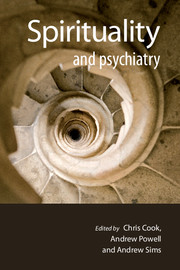Book contents
- Frontmatter
- Contents
- List of contributors
- List of tables, boxes and figures
- Foreword
- Preface
- The Spirituality and Psychiatry Special Interest Group of the Royal College of Psychiatrists
- 1 Spirituality in psychiatry
- 2 Assessing spiritual needs
- 3 Psychosis
- 4 Suicide
- 5 Child and adolescent psychiatry
- 6 Psychotherapy
- 7 Intellectual disability
- 8 Substance misuse
- 9 Neuroscience of the spirit
- 10 Spiritual care in the NHS
- 11 The transpersonal perspective
- 12 Religion and religious experiences
- 13 Pathological spirituality
- 14 Ageing
- Index
2 - Assessing spiritual needs
Published online by Cambridge University Press: 02 January 2018
- Frontmatter
- Contents
- List of contributors
- List of tables, boxes and figures
- Foreword
- Preface
- The Spirituality and Psychiatry Special Interest Group of the Royal College of Psychiatrists
- 1 Spirituality in psychiatry
- 2 Assessing spiritual needs
- 3 Psychosis
- 4 Suicide
- 5 Child and adolescent psychiatry
- 6 Psychotherapy
- 7 Intellectual disability
- 8 Substance misuse
- 9 Neuroscience of the spirit
- 10 Spiritual care in the NHS
- 11 The transpersonal perspective
- 12 Religion and religious experiences
- 13 Pathological spirituality
- 14 Ageing
- Index
Summary
The most important objective in psychiatry is to get alongside the patient
[Poole & Higgo, 2006: p. 2]There is no better way to ‘get alongside’ the patient than to enquire sympathetically about what gives his or her life most meaning and what helps most in adversity. These questions necessarily point towards spirituality and in the direction of a person's strengths rather than deficits.
Poole & Higgo (2006), two experienced and committed psychiatrists, encourage a narrative approach to understanding patients and emphasise that as well as any weaknesses operating in their lives, assessment has to include patients’ strengths. However, both they and the authors writing on assessment in another recent book (Meaden & Farmer, 2006), emphasise diagnosis and problem-listing. ‘Cultural and spiritual issues’ are virtually ignored, being mentioned only once in the two texts (in Meaden & Farmer, section on ‘Lifestyle assessments’, p. 70).
We therefore seek to fill a vital gap in the literature on psychiatric assessment. This chapter expands on an earlier paper (Culliford, 2007a) and is influenced by the profession's growing acceptance of the strengths perspective, ‘which posits clients’ personal and environmental strengths as central to the helping process’ (Hodge, 2001a). As well as asking ‘Why’ the spiritual needs of psychiatric patients should be addressed, we also ask questions about ‘how’, ‘who’ and ‘when’ (Koenig, 2002). We discuss quantitative v. qualitative approaches, and also narrative v. interpretative frameworks for understanding spirituality as necessarily intrinsic to optimal care-planning in mental healthcare.
Why assess a person's spirituality?
The reasons for assessing spiritual aspects of psychiatric patients’ lives, including their spiritual needs, are complex (Culliford, 2002b). In addition to discovering personal and environmental strengths on which to draw, the more obvious include:
The very nature of spirituality as a source of vitality, motivation and a healthy sense of belonging and being valued.
The long historical relationship between religion, medicine and mental healthcare.
The patients’ wishes as well as those of carers.
The epidemiology of spirituality/religion and mental health.
The influence of spirituality/religion on the attitudes and decisions of psychiatric staff.
The nature of spirituality
Spirituality is universal, yet unique to every person. It is essentially unifying and applies to everyone, including those who do not believe in God or a ‘higher being’.
- Type
- Chapter
- Information
- Spirituality and Psychiatry , pp. 16 - 38Publisher: Royal College of PsychiatristsPrint publication year: 2009

